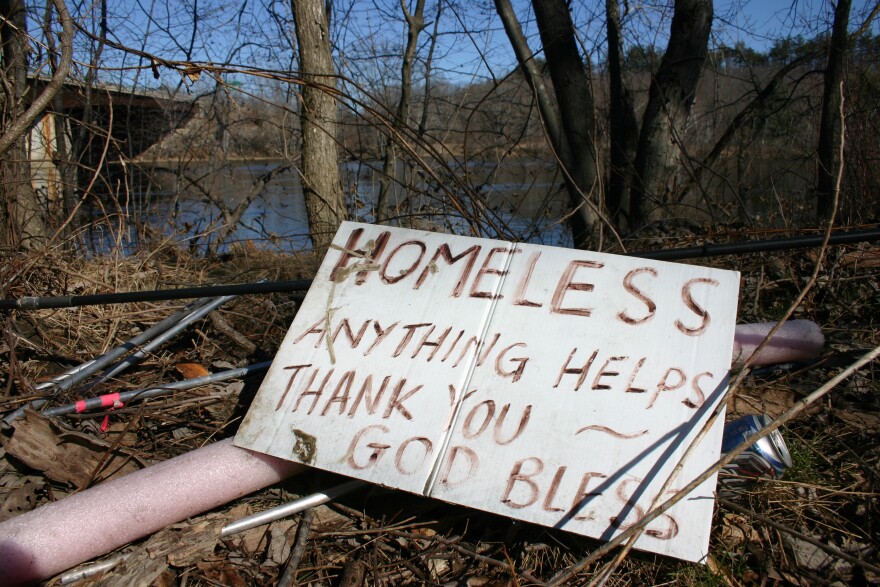Ten years ago policy makers in New Hampshire made an ambitious promise: to end homelessness by 2016. We haven’t gotten there yet.
As part of our special series on homelessness called 'No Place To Go,' NHPR's Jack Rodolico and Natasha Haverty reported the story of one homeless man, Gene Parker, who lived on the streets of Concord for five years before being struck and killed by a car this winter.
Cathy Kuhn directs New Hampshire’s Coalition to End Homelessness and joined NHPR’s Peter Biello to discuss where the issue stands today.
Did you know Gene Parker? Can you tell us about his death this winter, which rippled across the homeless and advocate communities here in Concord?
I did not know Gene personally. I know his death raised awareness about some of the issues we are seeing in our communities across the state. It was extremely tragic.
There were many folks who knew him, and who had worked with him, who were trying to get him into housing. And unfortunately that just didn’t happen fast enough. We are trying to figure out some better ways that we can respond more quickly so that these things don’t happen in the future.
It seems like, back in 2006, there was a real political moment when politicians, advocates, and police officers were all rallying around the idea of ending homelessness. There was a decision to write the ten year plan to end homelessness. Take us back to that moment. What was it like then?
This was momentum that was happening across the country. Communities across the country were being encouraged to write these plans to end homelessness, and many of them did. You’re right—it did represent a coming together from folks from different sectors to try to focus on this issue.
From the time we wrote it, one thing we learned is that when you’re writing these plans, ten years is a really long time. Once you’re one year, two years, three years into it, the realities have really changed. Environmental realities, realities of what the population is facing, and budgetary realities have changed. Often times, once you’re five years into it, it can be hard to go back and measure what you’ve done, or look at that plan going forward. You’re in a really different context and environmental reality.
It certainly it wouldn’t happen overnight, but here we are, ten years after the initial plan. By the state’s own count, on one night this winter there were 1,369 homeless people in the state, and the Department of Education counted more than 3,000 homeless school kids in 2013. Those numbers have changed since 2013, but why are we so far from reaching the goal of ending homelessness at this point?
First of all, there have been some gains. Overall homeless numbers have been reduced since 2011 in our state, and we are very excited about that.
A lot of it has to do with resources. Homelessness is a very complex problem. There are so many different things that can drive an individual or a family into homelessness. So we are talking about the coming together of many different systems of service that are needed to make a difference on this issue. Those include mental health services, child care services, employment services, and physical health services. All of that is needed if we are really going to make a difference in solving this issue. And that’s not to mention the most important piece, which is the housing.
Tell us about Housing First, and how it can be used for everybody that might be homeless.
Housing First was developed primarily for folks who are the long-time homeless—those chronic homeless populations. It was developed with the recognition that sometimes they are not able to become “housing-ready” before they get into a program.
What does that mean, “housing-ready?”
In the past, homeless service providers would say, “Before we put you into housing, we want to try to stabilize you. We want you to be successful in your housing.”
“Stabilize” meaning if they’re addicted to a drug, make sure they are sober?
Yes, they would provide some assistance there, or try to get you an income—those sorts of things. Housing First kind of turns that on its head and says, “You know what, we need to put you into housing first, and then we can work with you to stabilize you.” It’s a very low barrier housing model. Folks who many have criminal backgrounds, or who may be using a substance, wouldn’t be precluded from entering housing.
The research has been showing, across the country, that it can be very successful at getting those who are the most chronically homeless and vulnerable off the streets quickly.
Communities across our state are really just implementing that now, for the most part. A decade ago we weren’t even really talking about Housing First here in New Hampshire.
But there are no firm numbers on either how many people use it, or how much you would have saved?
In New Hampshire I’ve not seen a study done. I’ve seen some in other areas of the country that can show anywhere from $10,000 to $50,000 dollars in funding saved in housing one single person.








